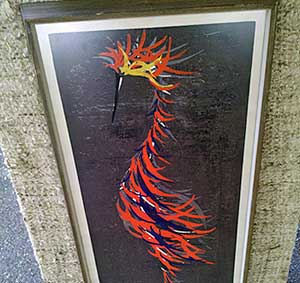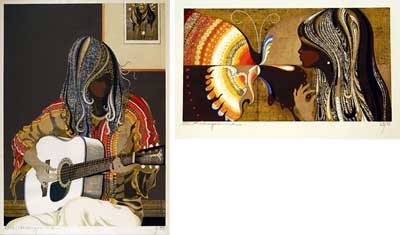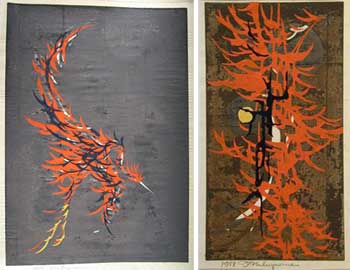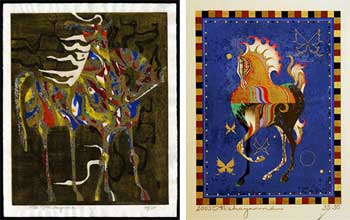I had almost breezed past the print when its fiery colors forced me into a double-take. The splashes of reds and a bold spot of yellow popped against the black background and just about willed me to stop. It wasn’t the type of print that normally grabbed me at auction – it looked like a stylized bird or flamingo – but there was “something” about this one.
For an instant, it reminded me of the Alvin Ailey Company’s signature ballet “Firebird,” and in my head I could still see the dancer in red burning up the stage, overtaking it as much as this bird claimed all the space in the print.

The name on the print was T. Nakayama, and it was dated 1958. It was one of several interesting pieces of artwork at the auction house’s Modern Design sale. I had arrived late because I didn’t expect to find much that I could afford in the catalog portion of the sale, which normally drew phone and online bidders with big bucks. So, I took a stab at trying to find something affordable in the non-catalog sale, of which the firebird painting was one of the offerings. (Click on the photo above for a fuller view.)
The print was set in one of those old-fashioned frames with the straw-like surface from the 1950s. It looked to be in good condition, although that’s hard to tell with artwork under glass.
I was curious about the artist, so I Googled the name and learned that he was Tadashi Nakayama, a Japanese artist born in 1927 and known for his woodblock prints. I found another of the same print on the web titled “Incarnation (Moku).” It was described as a colored woodblock print.

Born on the northwest coast of Japan in Niigata, Nakayama began sketching at age 14 and knew by the time he was 17 that he wanted to be an artist. He traveled to Europe in the 1960s and was influenced by Indian and Persian miniatures as well as Italian masters, according to a biography on the Hendricks Art Collection website. He would find his calling, though, in the long-honored art of Japanese woodblock printing.
His use of woodblock printing is said to be painstaking, with him using up to “23 blocks, 48 colors and 57 stages of printing,” according to the authors of a 1983 book on the artist titled “Tadashi Nakayama: His Life and Work.” The artist was described as reclusive and not a self-promoter of his works.

Nakayama produced his bird prints – like the one at auction – from around 1956 to 1964 as the “Phoenix” or “Incarnation” series that portrayed over-sized cranes in different poses. According to his biography on the Hendricks site:
“the backgrounds of these works are dark, but the figures are printed in strong reds, yellows, and greens especially mustard green; a color which he began to use with greater frequency. Concurrently, Nakayama began to portray the female form with wind-blown hair, with variations on the human form with rhythm and motion. Butterflies, multicolored and overlapping appear in these earliest works. His horses of this period are motionless or active with flowing manes printed in a multitude of colors.”
It was good to learn that the bird in the auction print was a crane and not a flamingo.
Nakayama began creating his horse prints in the 1970s, his first a woodblock titled “Ema.” It was followed by other versions of the horse, including Crimson Ema and Rainbow Ema. His horse prints appeared to be among his most popular. After seeing a few of them online, I understood why.

His works are in the Philadelphia Museum of Art, the Fine Arts Museum of San Francisco and the National Gallery of Victoria in Australia, among other museums. Here are some of his prints and their selling prices.
At auction, the bidding went back and forth only for a short while on the bird print, with the high bidder taking it home for around 30 bucks. In April, an “Incarnation” print sold for $400 at an auction in Florida. At an auction in 2010 in Chicago, most of Nakayama’s prints were not sold, but the few that did sell went for up to $2,000.

I own two Japanese artist’s prints: One is a variation of the Three figures setting out to the fields through the early morning haze by Tadashi Nakayama and the other by an artist who signed the print Ryuko. How might I learn the value of the prints?
Hi, here are two blog posts I wrote about how to determine the value of items:
Tips on figuring out what your stuff is worth
Need to find the value of an item? Try eBay, then Google
Good luck.
Bought one of his “horse” woodblock prints in 1967 in Tachikawa, outside of Tokyo, for $14.00. I’ve seen one online for sale for $1800! Love mine! I’ve had it for 47 years so I’ll keep it and let my heirs sell it.
Just would like to point out that the work here (Incarnation/Moku) is unlimited series like many others he made at that time. Basically they are still been printed (!!) and with the same signature&year (!!!). These are not much value, in auction the correct value would be 100-200USD.
Came across this article when I googled about nakayama. Back in 2003 I was stationed in Iwakuni Japan where they had a “tent sale” for the local merchants to come on base and sell things to the Marines there. A Tokyo art gallery was there and they had the “Rainbow Ema” on display. As I walked by it I did a double take because I was so captivated by the colors. I bought it right then and there for $1800 I believe and never regretted it. I later found out the the art gallery closed down also. So now there is a T. Nakayama hanging in my bedroom here in Texas.
Hi Andrew. Good for you I regret not buying the one at auction (unfortunately, that happens to me quite often).
Sherry
I have the same Incarnation (Moku) woodblock in my home. I found it in an obscure little shop around Palisades Park, NJ in 1976 and was so struck by its bold beauty that I had to buy it. It probably cost less than $20, was framed in a white bamboo style frame that I painted glossy black, and I have loved it and taken it with me everywhere I’ve moved for the past 37 years. I couldn’t find anything about the artist a few years ago when I first searched online but today when I googled his name, lots of information appeared. I am so happy that I own one of his creations.
Sherry, thank you for sharing your information on this particular woodblock.
jude
Hi Jude. It was a pleasure being introduced to and learning more about Tadashi Nakayama and his works.
Sherry